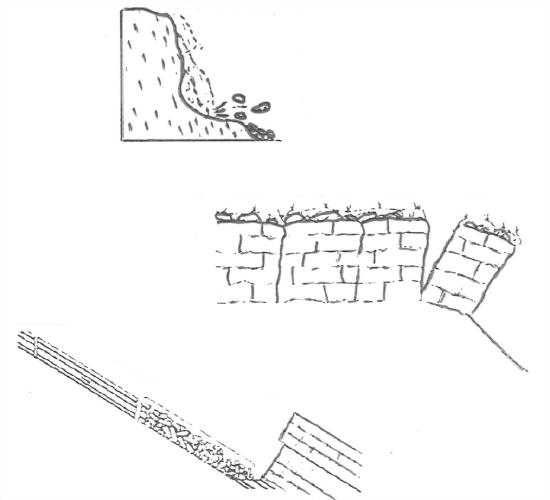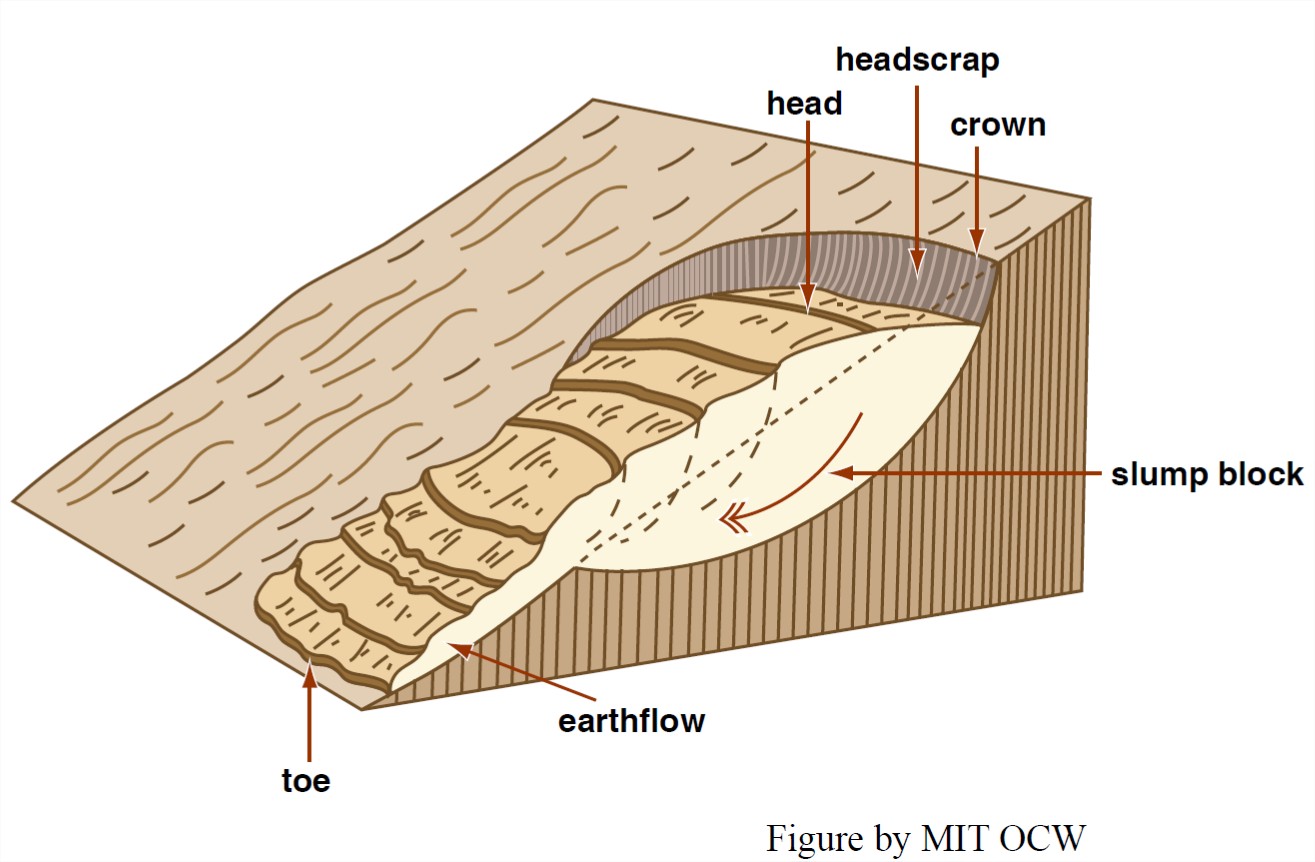10.5: Landslides
- Page ID
- 13508
As noted above, the term landslide is used for a variety of downslope movements of rock and regolith. These movements vary greatly in size, speed, and mode of movement. The simplest to understand (see Figure 10-9), and which are dealt with only briefly here, are rock falls (rapid fall of rock material down a cliff face), rock topples (downslope collapse of an originally vertical slab of rock that becomes detached along vertical fractures from a main rock mass), and rock slides (whereby a tabular mass of rock glides down a slope, which is usually underlain by more of the same rock, with planes of weakness parallel to the slope)
Another characteristic kind of landslide, in which a large mass of earth or rock material moves downslope along a discrete shear surface of failure, is called a slump (see Figure 10-10). The underlying surface is concave upward, and the mass rotates, in the sense of becoming more and more tilted upslope as it moves downslope. As the head of the slump evacuates the original space, a well- defined steep headscarp develops. The downslope segment of the slump, near the toe, commonly flows out onto the preexisting land surface as an earthflow, often with transverse ridges caused by compression as the earthflow feels the frictional resistance of the underlying surface. Slumps like this typically move slowly—not so fast that you can’t get out of the way. They are especially common in regions with steep slopes, thick layers of regolith rich in fines, and occasional heavy rains. Many have occurred in coastal central and southern California in historic times. In many cases they have been triggered by careless undercutting of the base of a slope during road construction or other excavations.

The largest and most destructive of landslides originate by failure of enormous masses of partially weathered and strongly fractured rock perched high on a mountain slope. Failure, along a master underlying slip plane, causes the mass of material to accelerate downslope at speeds in excess of a hundred meters per second. Most of the famous landslides in history, and in prehistory as well, have been of this kind. Failure is sometimes triggered by heavy rains, especially in springtime after a thaw, or by undercutting at the base of the slope. Others happen just at random—when the time has come for failure. There may be premonitory slow movement before failure, but prediction is difficult. Volumes of rock material involved can be many cubic kilometers.

In some cases, these large and rapid landslides have run out for long distances beyond the base of the slope down which they traveled, for several kilometers. The mechanism(s) that allow such long runouts over gentle slopes are not entirely clear. For some such landslides, it’s been proposed, on good theoretical and observational grounds, that the slide became launched into the air, perhaps when moving over a “lip” of bedrock, and then rode on a cushion of compressed air. Friction at the lower surface would then be far less than in movement over solid materials. (Think in terms of air hockey.) When the cushion of air is finally depleted, by upward flow through the porous and permeable moving material, the slide grinds to a halt.
As you can imagine, some such landslides have resulted in great loss of life. The worst in recorded history was in Peru in 1970, which involved an enormous volume of rock and ice that moved at speeds of over 300 kilometers per hour and killed as many as 40,000 people. Another famous landslide occurred in northern Italy in 1963, when the entire mountainside, a slab 2 km long, 1.6 km wide, and 250 m thick, flanking the Vaiont Reservoir failed and slid into the reservoir, causing a catastrophic flood that killed more than two thousand people living in the valley below the dam.
This course is oriented toward what happens on the land surface of the continents, but it’s important to point out here that the very largest landslides known have occurred undersea. It’s only been in recent years, with the advent of increasingly sophisticated surveying and imaging techniques, that their extent and importance have become clear. The two locales where the largest of such landslides have been observed are on the flanks of the great Hawaiian shield volcanoes (much the greater part of whose volumes lie below sea level) and along the margins of the continents, below the break in slope at the edge of the continental shelf. Some of these are truly enormous, with volumes of thousands of cubic kilometers.


